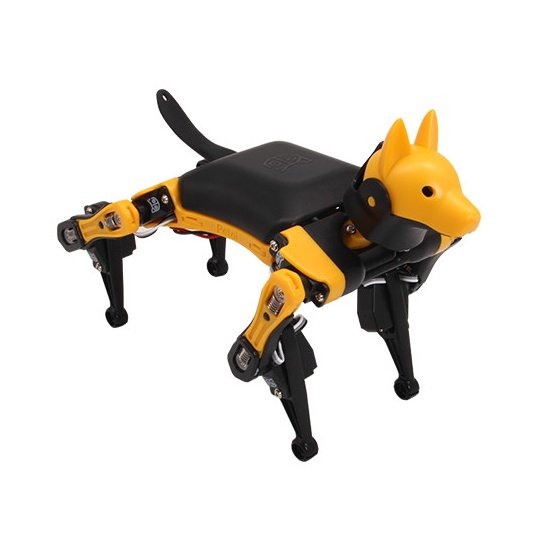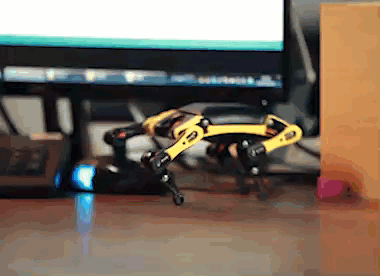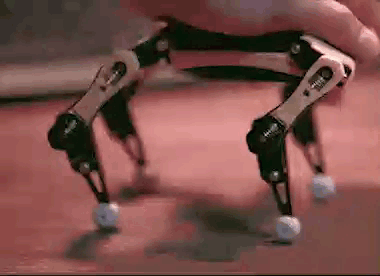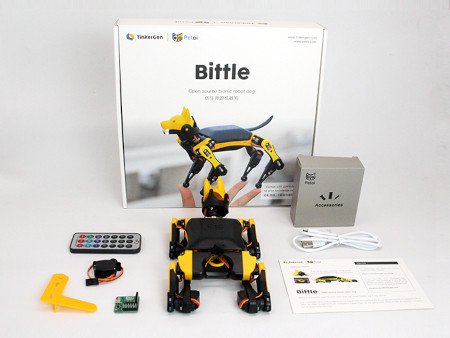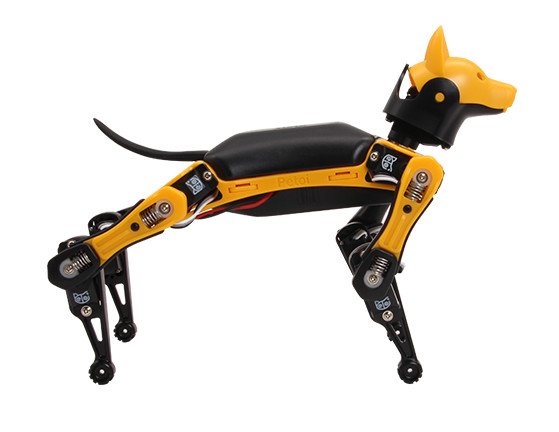Description: Petoi Bittle - bionic dog educational robot Seeedstudio 114992499
Petoi Bittle is abionic dog-an educational robot, which was created through the cooperation of the popular companyPetoiandTinkerGen. Small size, agile and maneuverable, made of high quality components. It can perform tricks like real animals. For more advanced users, it is also possible to transform Petoi Bittle into a full-fledgedAIrobot, which makes the bionic dog not onlya fantastic toy, but also becomes an effective tool for learning and research.
Feature Overview
- The unique bionic systemenables dynamic movements with excellent coordination. It also allows for greater freedom of movement when moving over uneven terrain.
- Therich development environmentmeans that Petoi Bittle can be programmed in the CodeCraft graphical editor or the popular Arduino language. The Bittle C code is completely open source, so anyone can have insight into it and modify it freely.
- Itcomes with a custom Arduino-based control boardthat features an Atmega328P chip. It uses an Arduino Uno chip to coordinate movements and allows you to control at least 12 PWM outputs.
- Grove's 4 interfacesmake the design freely expandable with additional peripherals such as ultrasonic or infraredsensors. It is also possible to use artificial intelligence, via Raspberry Pi or a derivative chip.
Construction of the Petoi Bittle
The basic components, on which the whole operation technique is based, are servos located in eachjoint- shoulder, hip and head. In the lower part of the quadruped, i.e. on the lower abdomen,a lithium-ionbattery is placed. Under the black cap there is amotherboardwith peripheral modules.
Structure of the quadcopter
The skeleton of the quadcopter consists ofinnovative interlocking 3D elements, the use of which reduces wear and tear on components, including screws and springs. The components are obtained throughinjection molding, which makes the components durable, protects electronic parts, prevents collisions and minimizes the entry of dust into the interior. The Petoi Bittle has undergone pressure tests and trials that show it can withstand being stepped on by an adult.The robot is not waterproof.
Programming environment
The robot can be coded usinggraphical programming,C/C++orPythonlanguage. Programming the Bittle Petoi does not cause problems even for beginners. It also comes with a pre-installed system, with basic fundamentals. To take advantage of Python programming, external components are needed that are not included in the basic kit.
Graphical programming course and technical support
A STEM team of professional teachers developed a graphical programming course for the Petoi Bittle robot. The course consists of 16 lessons and is intended for people who have already been exposed to graphical programming and have a basic knowledge of the subject. For complete beginners, we recommend starting with the CodeCraft course, which is an introduction to the environment.
The extensive online community provides great technical support. Up-to-date information about Bittle can be found athttps://www.tinkergen.com/, and online tutorials, projects, and lesson ideas are available on the TinkerGen and Make2Learn learning platforms.
Compatible with Raspberry Pi / ESP32
The Bittle NyBoard V1 control board is a counterpart to the popular Arduino board. It has a built-in 2x5 socket, which is used to connect a Raspberry Pi or other AI chips to bring artificial intelligence to your bionic quadcopter.
Kit contents
- Bionic robot dog
- IR remote control
- USB to UART converter
- P1S servo motor
- MicroUSB connection cable
- Joint Tuner
Technical specifications
- Control board:
- model: NyBoardV1_1
- chip: ATmega328P
- clocking: 16 MHz
- SRAM: 2 kB
- Flash memory: 32 kB
- internal EEPROM: 1 kB
- I2C EEPROM memory: 8 kB
- Grove connectors: 4 pcs.
- communication interfaces: 1 x UART, 1 x I2C, 1 x SPI
- Servomechanism:
- model: P1S
- voltage: 8.4 V
- range: 270°
- torque: 3.15 kg/cm
- Rechargeable battery:
- type: lithium-ion
- number of cells: 2
- charging: with a cable with a microUSB connector
- voltage: 7,4 V
- current: 5 A
- battery capacity: 1000 mAh / 74 Wh
- Spring-loaded upper legs
- Material: impact-resistant ABS plastic injection molded
- Dimensions: 200 x 110 x 150 mm
- Weight: 290 g
Useful links |
